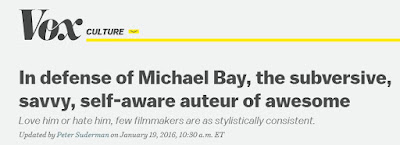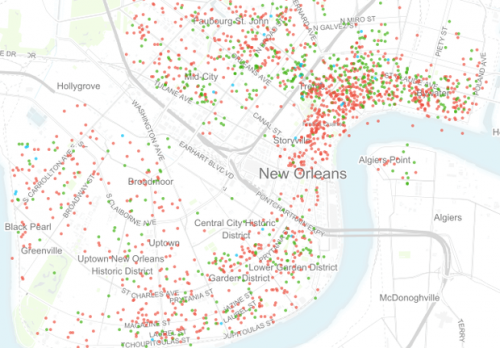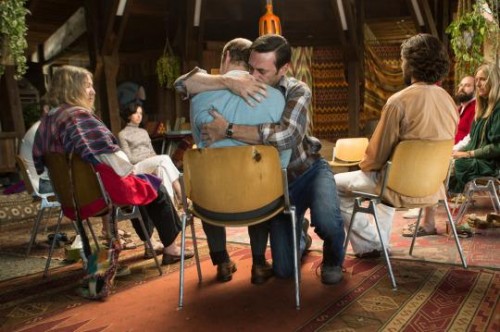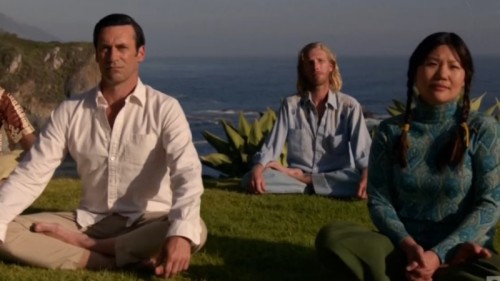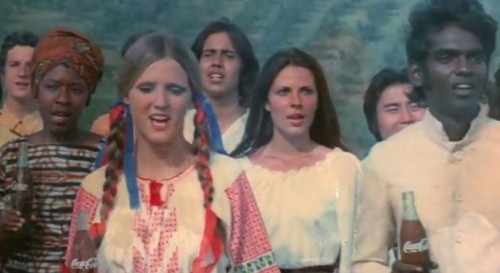Despite the maxim about familiarity breeding contempt, we usually like what’s familiar. With music for example, familiarity breeds hits in the short run and nostalgia in the long run. The trouble is that it’s tempting to attribute our liking to the inherent quality of the thing rather than its familiarity. With movies, film buffs may make this same conflation between what they like and what they easily recognize.
That’s one of the points of Scott Lemieux’s takedown of Peter Suderman’s Vox article about Michael Bay.
Suderman hails Bay as “an auteur — the author of a film — whose movies reflect a distinctive, personal sensibility. Few filmmakers are as stylistically consistent as Bay, who recycles many of the same shots, editing patterns, and color schemes in nearly all of his films.”
But what’s so great about being an auteur with a recognizable style? For Lemieux, Michael Bay is a hack. His movies aren’t good, they’re just familiar. Bay’s supporters like them because of that familiarity but then attribute their liking to some imagined cinematic quality of the films.
My students, I discovered last week, harbor no such delusions about themselves and the songs they like. As a prologue to my summary of the Salganik-Watts MusicLab studies, I asked them to discuss what it is about a song that makes it a hit. “Think about hit songs you like and about hit songs that make you wonder, ‘How did that song get to be #1?’” The most frequent answers were all about familiarity and social influence. “You hear the song a lot, and everyone you know likes it, and you sort of just go along, and then you like it too.” I had to probe in order to come up with anything about the songs themselves – the beat, the rhymes, even the performer.
Lemieux cites Pauline Kael’s famous essay “Circles and Squares” (1963), a response to auteur-loving critics like Andrew Sarris. She makes the same point – that these critics conflate quality with familiarity, or as she terms it “distinguishability.”
That the distinguishability of personality should in itself be a criterion of value completely confuses normal judgment. The smell of a skunk is more distinguishable than the perfume of a rose; does that make it better?
Often the works in which we are most aware of the personality of the director are his worst films – when he falls back on the devices he has already done to death. When a famous director makes a good movie, we look at the movie, we don’t think about the director’s personality; when he makes a stinker we notice his familiar touches because there’s not much else to watch.
Assessing quality in art is difficult if not impossible. Maybe it’s a hopeless task, one that my students, in their wisdom, refused to be drawn into. They said nothing about why one song was better than another. They readily acknowledged that they liked songs because they were familiar and popular, criteria that producers, promoters, and payola-people have long been well aware of.
“In the summer of 1957,” an older friend once told me, “My family was on vacation at Lake Erie. There was this recreation hall – a big open room where teenagers hung out. You could get ice cream and snacks, and there was music, and some of the kids danced. One afternoon, they played the same song – ‘Honeycomb’ by Jimmie Rodgers – about twenty times in a row, maybe more. They just kept playing that song over and over again. Maybe it was the only song they played the whole afternoon.”
It wasn’t just that one rec hall. The people at Roulette Records must have been doing similar promotions all around the country and doing whatever they had to do to get air play for the record. By the end of September, “Honeycomb” was at the top of the Billboard charts. Was it a great song? Assessment of quality was irrelevant, or it was limited to the stereotypical critique offered by the kids on American Bandstand: “It’s got a good beat. You can dance to it.” Of course, this was before the 1960s and the rise of the auteur, a.k.a. the singer-songwriter.
Hollywood uses the same principle when it churns out sequels and prequels – Rocky, Saw, Batman. They call it a “franchise,” acknowledging the films had the similarity of Burger Kings. The audience fills the theaters not because the movie is good but because it’s Star Wars. Kael and the other anti-auteurists argue that auteur exponents are no different in their admiration for all Hitchcock. Or Michael Bay. It’s just that their cinema sophistication allows them to fool themselves.
Originally posted at Montclair Socioblog. Big hat tip to Mark at West Coast Stat Views.
Jay Livingston is the chair of the Sociology Department at Montclair State University. You can follow him at Montclair SocioBlog or on Twitter.

